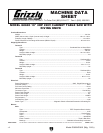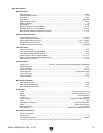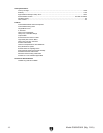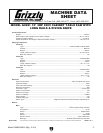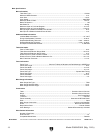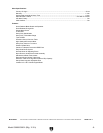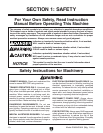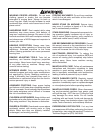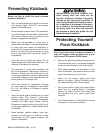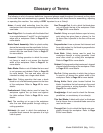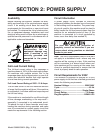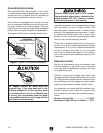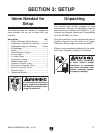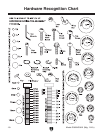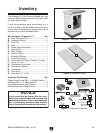
-12-
Model G0690/G0691 (Mfg. 11/10+)
Additional Safety for Table Saws
HAND POSITIONING. Never purposely touch a
saw blade during operation. Always keep hands/
fingers out of the blade path; place them where
they cannot slip into the blade accidentally. Never
reach around, behind, or over the blade. Touching
a spinning saw blade will cause serious laceration
or amputation injuries.
BLADE GUARD. Use the blade guard for all
“through cuts” for which it can be used. (A through
cut is an operation where the blade cuts complete-
ly through the top of the workpiece.) Make sure
the blade guard is installed and adjusted correctly;
promptly repair or replace it if damaged. Always
re-install blade guard immediately after operations
that require its removal. Operating saw with the
blade guard removed greatly increases the risk of
severe laceration or amputation injuries from acci-
dental blade contact.
RIVING KNIFE. Use the riving knife for all “non-
through cuts” for which it can be used. (A non-
through cut is an operation where the blade does
not cut through the top of the workpiece.) Make
sure the riving knife is aligned and positioned cor-
rectly; and promptly repair or replace it if damaged.
Using the riving knife incorrectly will increase the
risk of kickback or accidental blade contact.
KICKBACK. Kickback occurs when the saw blade
ejects the workpiece back toward the operator.
Know how to reduce the risk of kickback, and learn
how to protect yourself if it does occur.
FEEDING WORKPIECE. Feeding the workpiece
incorrectly will increase risk of kickback. Never
start the saw with a workpiece touching the blade;
allow the blade to reach full speed before cutting.
Only feed the workpiece against the direction of
blade rotation. Always use some type of guide
(fence, miter gauge, sliding table or sled, etc.) to
feed the workpiece in a straight line. Never back a
workpiece out of a cut or try to move it backwards
or sideways after starting a cut. Feed cuts all the
way through to completion. Never perform any
operation “freehand” (making a cut without using a
fence, miter gauge, or other guide).
FENCE. Make sure the fence remains properly
adjusted and parallel with the blade. Always lock
the fence in place before using. Using or adjusting
the fence incorrectly will increase risk of kickback.
PUSH STICKS/BLOCKS. Use push sticks or push
blocks whenever possible to keep your hands far-
ther away from the blade while cutting; in the event
of an accident these devices will often take dam-
age that would have happened to hands/fingers.
CUT-OFF PIECES. Never use your hands to move
cut-offs away from the blade while the saw is run-
ning. If a cut-off becomes trapped between the
blade and table insert, turn the saw OFF and allow
the blade to completely stop before removing it.
BLADE ADJUSTMENTS. Adjusting the blade
height or tilt during operation increases the risk of
crashing the blade and sending metal fragments
flying with deadly force at the operator or bystand-
ers. Only adjust the blade height and tilt when the
blade is completely stopped and the saw is OFF.
CHANGING BLADES. Always disconnect power
before changing blades. Changing blades while
the saw is connected to power greatly increases
the injury risk if saw is accidentally powered up.
DAMAGED SAW BLADES. Never use blades
that have been dropped or otherwise damaged.
Damaged blades can fly apart and strike the oper-
ator with shards of metal.
DADO AND RABBET OPERATIONS. DO NOT
attempt dado or rabbeting operations without
first reading those sections in this manual. Dado
and rabbeting operations require special attention
because they must be performed with the blade
guard removed.
CUTTING CORRECT MATERIAL. Never cut
materials not intended for this saw; only cut natural
and man-made wood products, laminate covered
wood products, and some plastics. Cutting metal,
glass, stone, tile, etc. increases the risk of operator
injury due to kickback or flying particles.



